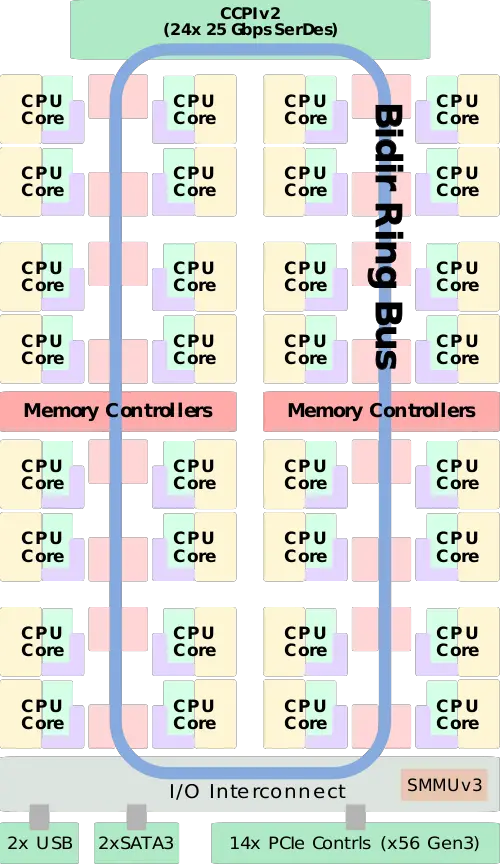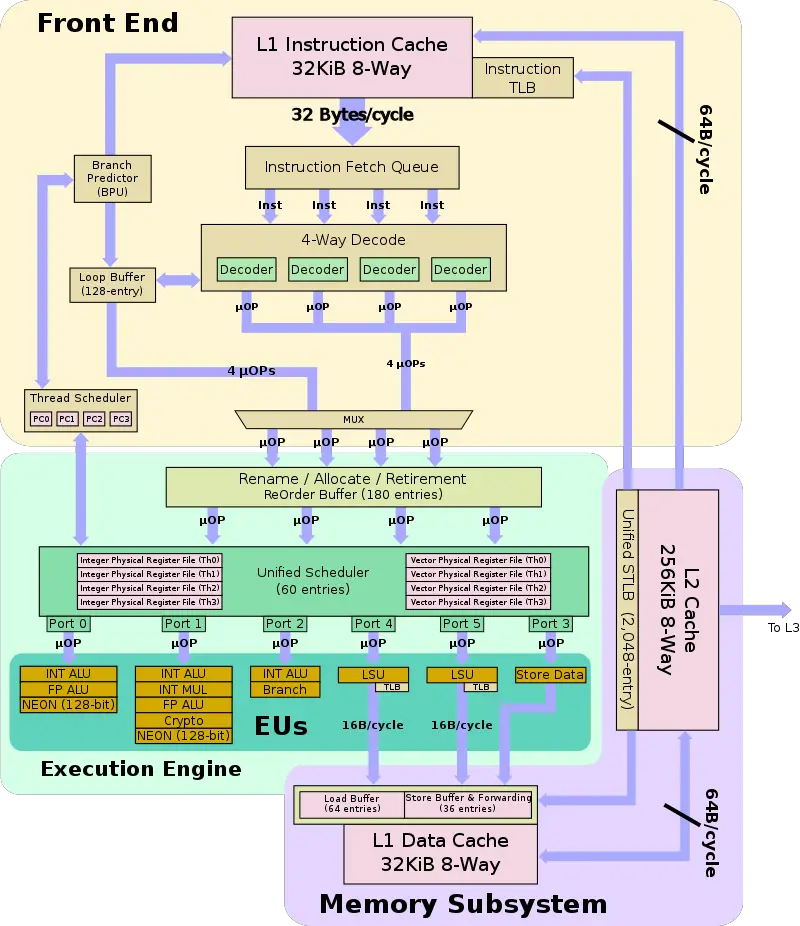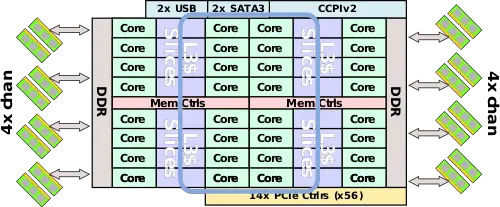(→Core) |
(→Execution engine) |
||
| Line 142: | Line 142: | ||
Sitting between the [[instruction decode|decoder]] and the [[instruction scheduler|scheduler]] is a [[loop buffer]]. The loop buffer, in conjunction with the [[branch predictor]], will queue recent tight loop operations. The buffer will play back the operations repeatedly until a branch take occurs. When this takes place, the front-end (instruction fetch, decode, etc..) is largely power-gated in order to save power. Although Broadcom originally told us the buffer was had 48-entries, when the product was re-released by [[Cavium]] in late 2018, WikiChip was unable to confirm this number. | Sitting between the [[instruction decode|decoder]] and the [[instruction scheduler|scheduler]] is a [[loop buffer]]. The loop buffer, in conjunction with the [[branch predictor]], will queue recent tight loop operations. The buffer will play back the operations repeatedly until a branch take occurs. When this takes place, the front-end (instruction fetch, decode, etc..) is largely power-gated in order to save power. Although Broadcom originally told us the buffer was had 48-entries, when the product was re-released by [[Cavium]] in late 2018, WikiChip was unable to confirm this number. | ||
| − | + | === Execution engine === | |
Vulcan's back-end handles the execution of out-of-order operations. Vulcan's back-end has been substantially enhanced from prior designs including a complete redesign of the [[instruction scheduler|scheduler]]. Most of the improvements dealt with entirely reworking the scheduler in order to more efficiently extract additional instruction-level parallelism opportunities. From decode, instructions are sent to the [[Reorder Buffer]] (ROB) at the rate of up to 4 µOPs each cycle. | Vulcan's back-end handles the execution of out-of-order operations. Vulcan's back-end has been substantially enhanced from prior designs including a complete redesign of the [[instruction scheduler|scheduler]]. Most of the improvements dealt with entirely reworking the scheduler in order to more efficiently extract additional instruction-level parallelism opportunities. From decode, instructions are sent to the [[Reorder Buffer]] (ROB) at the rate of up to 4 µOPs each cycle. | ||
| − | + | ==== Renaming & Allocation ==== | |
In the prior XLP II microarchitecture, [[NetLogic]] had a five-queue instruction distributed scheduler mechanism whereby each queue is associated with certain execution units. In Cavium, Broadcom got rid of the distributed scheduler and replaced it with a more efficient unified scheduler, similar in design to Intel's {{intel|Skylake (Client)|Skylake|l=arch}}. | In the prior XLP II microarchitecture, [[NetLogic]] had a five-queue instruction distributed scheduler mechanism whereby each queue is associated with certain execution units. In Cavium, Broadcom got rid of the distributed scheduler and replaced it with a more efficient unified scheduler, similar in design to Intel's {{intel|Skylake (Client)|Skylake|l=arch}}. | ||
Vulcan's [[Reorder Buffer]] is 180-entry in size, an 80-entry increase over prior design. The ROB tracks all µOPs in flight. Vulcan renames and retires up to 4 µOPs per cycle. | Vulcan's [[Reorder Buffer]] is 180-entry in size, an 80-entry increase over prior design. The ROB tracks all µOPs in flight. Vulcan renames and retires up to 4 µOPs per cycle. | ||
| − | + | ==== Scheduler ==== | |
Vulcan uses a 60-entry unified scheduler. Each cycle, up to six µOPs can be issued to the execution units, a much wider design from the four µOPs issue in prior design. It's worth noting that in order to support four threads, Vulcan duplicates most of the logic for each thread such as all the registers, architectural states, program counters, and interrupts. Ready µOPs from any thread are issued on each cycle. | Vulcan uses a 60-entry unified scheduler. Each cycle, up to six µOPs can be issued to the execution units, a much wider design from the four µOPs issue in prior design. It's worth noting that in order to support four threads, Vulcan duplicates most of the logic for each thread such as all the registers, architectural states, program counters, and interrupts. Ready µOPs from any thread are issued on each cycle. | ||
| − | + | ==== Execution Units ==== | |
Up to six µOPs can be sent into Vulcan's six execution units each cycle. As far as integer operations, up to three operations can be issued each cycle. One of the ALUs also handles branch instructions. In the XLP II, there were two simple integer ALUs and a single complex integer ALU unit. Only the complex integer ALU unit was able to perform operations such as multiplication and division. Though unconfirmed, it's suspected that both ALUs can now do complex integer operations as well. | Up to six µOPs can be sent into Vulcan's six execution units each cycle. As far as integer operations, up to three operations can be issued each cycle. One of the ALUs also handles branch instructions. In the XLP II, there were two simple integer ALUs and a single complex integer ALU unit. Only the complex integer ALU unit was able to perform operations such as multiplication and division. Though unconfirmed, it's suspected that both ALUs can now do complex integer operations as well. | ||
| − | Vulcan has doubled the number of [[floating point]] units to two and widened them to 128-bit to support [[ARM]]'s {{arm|NEON}}} operations (prior design was only 64-bit wide). In theory, Vulcan's peak performance now stands at 8 FLOPS/cycle or 8 GFLOPS at 1 GHz. | + | Vulcan has doubled the number of [[floating point]] units to two and widened them to 128-bit to support [[ARM]]'s {{arm|NEON}}} operations (prior design was only 64-bit wide). In theory, Vulcan's peak performance now stands at 8 FLOPS/cycle or 8 GFLOPS at 1 GHz. |
==== Memory subsystem ==== | ==== Memory subsystem ==== | ||
Revision as of 00:34, 1 June 2018
| Edit Values | |
| Vulcan µarch | |
| General Info | |
| Arch Type | CPU |
| Designer | Broadcomm, Cavium |
| Manufacturer | TSMC |
| Introduction | 2018 |
| Process | 16 nm |
| Core Configs | 16, 20, 24, 28, 30, 32 |
| Pipeline | |
| Type | Superscalar, Superpipeline |
| OoOE | Yes |
| Speculative | Yes |
| Reg Renaming | Yes |
| Stages | 13-15 |
| Decode | 4-way |
| Instructions | |
| ISA | ARMv8.1 |
| Extensions | NEON |
| Cache | |
| L1I Cache | 32 KiB/core 8-way set associative |
| L1D Cache | 32 KiB/core 8-way set associative |
| L2 Cache | 256 KiB/core 8-way set associative |
| L3 Cache | 1 MiB/core |
| Succession | |
Vulcan is a 16 nm high-performance 64-bit ARM microarchitecture designed by Broadcom and later Cavium for the server market.
Introduced in 2018, Vulcan-based microprocessors are branded as part of the ThunderX2 family.
History
Vulcan can trace its roots all the way back to Raza Microelectronics XLR family of MIPS processors from 2006. With the introduction of their XLR family in 2009, Raza (and later NetLogic) moved to a high-performance superscalar design with fine-grained 4-way multithreading support. In 2011, Broadcom acquired NetLogic Microsystems and integrated them Broadcom's Embedded Processor Group.
In 2013, Broadcom announced that they have licensed the ARMv7 and ARMv8 architectures, allowing them to develop their own microarchitectures based on the ISA. Vulcan is the outcome of this effort which involved adopting the ARM ISA instead of MIPS and enhancing the cores in various ways. Vulcan development started in early 2012 and has was expected to enter mass production in mid-2015.
In 2017 Cavium acquired Vulcan from broadcom which was introduced later that year. In early 2018, Vulcan-based microprocessor entered general availability under the ThunderX2 brand.
Architecture
Vulcan builds on the prior MIPS-based XLP II microarchitecture. The design has been substantially improved and changed to execute ARM (based on the ARMv8.1 ISA).
Key changes from XLP II
- Converted to ARM ISA (from MIPS)
- Aarch64, Aarch32
- 16nm FinFET process (from 28 nm planar)
- 40% IPC improvement
- 25% higher clock (2.5 GHz, up from 2 GHz)
- Core
- Longer pipeline (15 stages, up from 13)
- Improved branch predictor
- Double fetch throughput (4, up from 2)
- New Decoder
- Decodes ARMv8.1 (Instead of MIPS64 R5)
- Decodes to micro-ops
- Roughly 10-20% more µOPs
- New loop buffer
- Execution Engine
- New scheduler
- Unified schedule (from distributed)
- 60 entries
- Unified schedule (from distributed)
- Large ROB (180 entries, up from 128)
- Execution Units
- New FP Unit (2, up from 1)
- Wider FP Units (128-bit, up from 64-bit)
- New scheduler
- Memory Subsystem
- Double load bandwidth (128-bit, up from 64-bit)
- New Store Data Unit
- Half L2 Cache Size (256 KiB, down form 512 KiB)
- Memory Controller
- DDR3 → DDR4
- 4 → 8 channels
- 1600 MT/s → 2666 MT/s
- 47.68 GiB/s → 158.9 GiB/s
Block Diagram
Entire Chip
Individual Core
Memory Hierarchy
- Cache
- L1I Cache
- 32 KiB, 8-way set associative
- L1D Cache
- 32 KiB, 8-way set associative
- L2 Cache
- 256 KiB, 8-way set associative
- L3 Cache
- 1 MiB/core slice
- Shared
- System DRAM
- 8 Channels
- DDR4, up to 2666 MT/s
- 1 DPC and 2 DPC support
- RDIMM, LRDIMM, NVDIMM-P support
- Single, Dual and Quad rank modules
- 8 B/cycle/channel (@ memory clock)
- ECC
- L1I Cache
- TLBs
- ITLB
- Dedicated instruction TLB
- DTLB
- TLB unit for each LSU
- STLB
- 2048-entry
- 4 KiB - 16 GiB pages
- ITLB
Overview
Scaled up from prior architectures in all vectors (performance, area, and TDP), Vulcan was designed to be a Xeon-class ARM-based server microprocessor. Vulcan features 32 high-performance custom-designed ARM cores fully compliant with ARMv8.1 along with their accompanying 1 MiB of level 3 cache slice (for a total of 32 MiB of shared last level cache). Since each core supports up to four simultaneous threads, the full configuration can support up to 128 threads. Supporting a large number of cores, are eight DDR4 channels capable of data rates of up to 2,666 MT/s, allowing for 170.7 GB/s of aggregated bandwidth.
The processor comes with 14 fully-configurable PCIe Gen3 controllers with 56 available lanes. The chip also has 2 USB 3 and 2 SATA 3 ports.
Vulcan supports up to two-way multiprocessing through their second-generation Cavium Coherent Processor Interconnect (CCPI2) capable of providing 600 Gbps of aggregated bandwidth.
Core
Vulcan is an out-of-order superscalar with support for up to four simultaneous hardware threads.
Front-end
Vulcan's front-end is tasked with fetching instructions from a ready thread instruction stream and feeding them into the decode in order to be delivered to the execution units. Since Vulcan supports up to four threads, a thread scheduler determines from which thread's instruction stream to operate on. This determination is done on each cycle with the help of the branch predictor with no added cost.
Fetch
Instruction fetch is done on a 32-byte window or 8 (4-byte) ARM instructions. This is twice the throughput of the previous architecture and is designed in order to better absorb bubbles in the pipeline. The instruction stream is decomposed into its constituent instructions where they are queued to go for the decoder. The queue is shared by all threads. The size of the queue has not been disclosed.
Decoding
Each cycle, up to four instructions are sent to the decoder. In prior design, Broadcom's products decoded MIPS instructions. With Vulcan, the switching to ARM meant the decoder had to be replaced with much more complex logic that decodes the original instruction and emits micro-ops. For the most part, there is a 1:1 mapping between instructions and µOP with an average of 15% more µOPs emitted from instructions. The extra complexity has added another pipeline stage to the decode.
Loop Buffer
Sitting between the decoder and the scheduler is a loop buffer. The loop buffer, in conjunction with the branch predictor, will queue recent tight loop operations. The buffer will play back the operations repeatedly until a branch take occurs. When this takes place, the front-end (instruction fetch, decode, etc..) is largely power-gated in order to save power. Although Broadcom originally told us the buffer was had 48-entries, when the product was re-released by Cavium in late 2018, WikiChip was unable to confirm this number.
Execution engine
Vulcan's back-end handles the execution of out-of-order operations. Vulcan's back-end has been substantially enhanced from prior designs including a complete redesign of the scheduler. Most of the improvements dealt with entirely reworking the scheduler in order to more efficiently extract additional instruction-level parallelism opportunities. From decode, instructions are sent to the Reorder Buffer (ROB) at the rate of up to 4 µOPs each cycle.
Renaming & Allocation
In the prior XLP II microarchitecture, NetLogic had a five-queue instruction distributed scheduler mechanism whereby each queue is associated with certain execution units. In Cavium, Broadcom got rid of the distributed scheduler and replaced it with a more efficient unified scheduler, similar in design to Intel's Skylake.
Vulcan's Reorder Buffer is 180-entry in size, an 80-entry increase over prior design. The ROB tracks all µOPs in flight. Vulcan renames and retires up to 4 µOPs per cycle.
Scheduler
Vulcan uses a 60-entry unified scheduler. Each cycle, up to six µOPs can be issued to the execution units, a much wider design from the four µOPs issue in prior design. It's worth noting that in order to support four threads, Vulcan duplicates most of the logic for each thread such as all the registers, architectural states, program counters, and interrupts. Ready µOPs from any thread are issued on each cycle.
Execution Units
Up to six µOPs can be sent into Vulcan's six execution units each cycle. As far as integer operations, up to three operations can be issued each cycle. One of the ALUs also handles branch instructions. In the XLP II, there were two simple integer ALUs and a single complex integer ALU unit. Only the complex integer ALU unit was able to perform operations such as multiplication and division. Though unconfirmed, it's suspected that both ALUs can now do complex integer operations as well.
Vulcan has doubled the number of floating point units to two and widened them to 128-bit to support ARM's NEON} operations (prior design was only 64-bit wide). In theory, Vulcan's peak performance now stands at 8 FLOPS/cycle or 8 GFLOPS at 1 GHz.
Memory subsystem
| This section is empty; you can help add the missing info by editing this page. |
All Vulcan Chips
| This section is empty; you can help add the missing info by editing this page. |
References
- Some information was obtained directly from Broadcom
- Some information was obtained directly from Cavium
See also
| codename | Vulcan + |
| core count | 16 +, 20 +, 24 +, 28 +, 30 + and 32 + |
| designer | Broadcomm + and Cavium + |
| first launched | 2018 + |
| full page name | cavium/microarchitectures/vulcan + |
| instance of | microarchitecture + |
| instruction set architecture | ARMv8.1 + |
| manufacturer | TSMC + |
| microarchitecture type | CPU + |
| name | Vulcan + |
| pipeline stages (max) | 15 + |
| pipeline stages (min) | 13 + |
| process | 16 nm (0.016 μm, 1.6e-5 mm) + |


